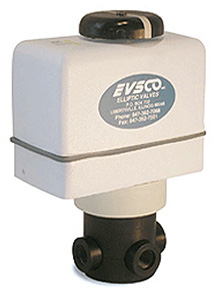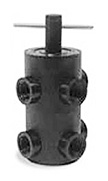Expanded design, cumbersome piping problems, additional actuation costs and a large footprint are often the results of individual valves performing redundant individual functions or tasks. By looking beyond yesterday’s selections you could avoid these cumbersome issues in the future.
Stackable Systems Avoid Redundancies
Valves today are easier to adapt and offer additional advantages you could benefit from. One example is Evsco’s modular Stack Valve System. Designs that utilize Stack Valve Systems generally handle comparable flows but reduce the complexity and costs, both upstream and downstream. Stack Valve Systems increase performance by reducing the number of actuators in the system leading to a more efficient compact design.
When compared to existing systems, Stack Valves consistently meet and exceed expectations because of these reasons.
- Stackable designs are compact and flexible.
- Their versatile design makes them highly configurable to meet sophisticated and diverse requirements.
- Stack valves can be easily disassembled for service or for adding options and functions.
- Assembly time is reduced.
- System space and overall footprint are lessened
- Operation is easy and reliable.
- Multiple Valves can be operated using one pneumatic or electric actuator.
- Stack valves are available in flow styles, sizes, with modular conceptual design.
- All wetted surfaces provide chemical resistance suitable for use with high purity or aggressive chemicals.
- Innovative valve designs enable a very high flow rate with a small footprint.
- Industry standard FNPT port connections are available for easy integration into a variety of systems.
Valves to Match Your Application
Evsco valves can be used in a wide variety of applications, including instrumentation, research and development, pilot and process sampling, gas chromatography, inks, P&P, medical, pharm., complex fluid transfer circuitry, remote control and positioning, and switching and transfer systems.
Evsco valves have a long history of being able to withstand demanding applications under a wide range of pressure, temperature, and corrosive conditions. Utilizing a wide variety of materials, porting arrangements and sizes, Evsco valves provide you the ability to select the most efficient and appropriate valve, whatever your requirements may be.
 Applications often require multiple actuated valves to run in series, which tags on the added baggage of complicated designs and higher costs. With applications that run valves in sequence or multiple actuated valves, each individual valve needs its own actuation. Purchasing several electric or pneumatic actuated units can significantly bump up costs, not to mention the cumbersome planning involved with creating the design footprint. Luckily, a solution exists for OEMs to avoid these added expenses and simplify their design.
Applications often require multiple actuated valves to run in series, which tags on the added baggage of complicated designs and higher costs. With applications that run valves in sequence or multiple actuated valves, each individual valve needs its own actuation. Purchasing several electric or pneumatic actuated units can significantly bump up costs, not to mention the cumbersome planning involved with creating the design footprint. Luckily, a solution exists for OEMs to avoid these added expenses and simplify their design. The ball valve hasn’t really evolved much since it was first invented in the 1950’s. Reaching the mature stage of its lifecycle, enhancements leveled off over time and it remained fairly constant for years. However, more could be done with traditional ball valve mechanisms if its inherent limitations were lifted and an alternative could replace it without disruption.
The ball valve hasn’t really evolved much since it was first invented in the 1950’s. Reaching the mature stage of its lifecycle, enhancements leveled off over time and it remained fairly constant for years. However, more could be done with traditional ball valve mechanisms if its inherent limitations were lifted and an alternative could replace it without disruption.